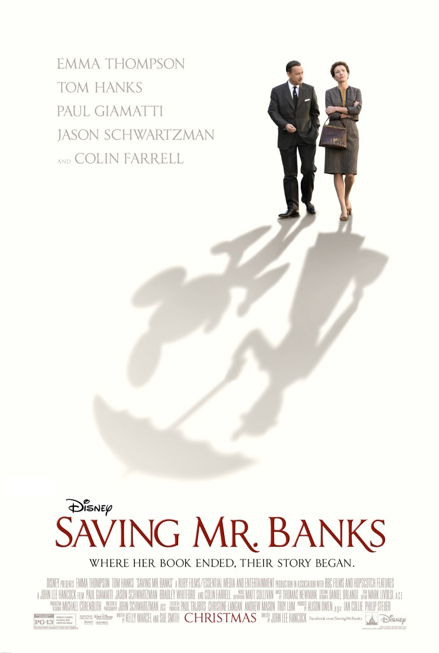
Saving Mr. Banks is a whimsical film chronicling the production of the highly acclaimed Disney movie Mary Poppins. It tells the true life story of Walt Disney and the efforts he made to convince the author of the popular Mary Poppins books to give him the movie rights. Overall, it is a heartwarming film that is likely to be enjoyed by most audiences, particularly those who adore Mary Poppins.
P.L. Travers (played by Emma Thompson) is the writer of the famous Mary Poppins children’s books. In the film, we learn that she worked hard to keep the movie rights from Walt Disney (played by Tom Hanks) for 20 years. It is not until Travers found herself in financial difficulties that she considered letting Disney woo her.
As one may expect from an author, Travers guards her character Mary Poppins with great affection. As a result, she has high standards for how she wishes Poppins to be portrayed on screen. Travers has a list of specific demands. Mary Poppins is not supposed to sing or make up words, quite unlike the Mary Poppins that Disney fans love.
{modulepos inner_text_ad}
But Walt Disney is willing to do whatever it takes to gain the movie rights, driven by a promise he has made to his children, assuring them that he would turn their favorite books into a movie.
The story that unfolds is charming and lighthearted, but there are moments of great depth as well. Flashbacks to Travers’ youth reveals that her father (played by Colin Farrell in the film) was an alcoholic, though she did not fully understand the tragedy of her father’s excessive drinking while it was happening.
What we learn is that the story of Mary Poppins, however fantastical it may be, is rooted in Travers’ disturbing family history. Because of that, she is particularly protective of her Mary Poppins.
In order for Disney to convince her to give him the rights, he must sell Travers on the magic that is Disney, and open up about his own difficult childhood. He ultimately proves that magic, fantasy, and wonder are vital for children to help them escape into a world that may be better than that which they may be trying to escape, an experience to which both Travers and Disney can relate. He tells her that the purpose of storytelling is to “restore order with imagination” and to “instill hope again and again.”
She begins to come around once it is clear to her that Disney does not intend to simply add Mary Poppins to his repertoire of children’s films, but that he too bears a strong sense of emotional connection to the beloved character.
Of course, we know what happens in the end — Disney makes Mary Poppins and it proves to be Disney’s most successful film at the Academy Awards, winning 5 Academies out of 13 nominations. The film’s estimated budget was approximately $6,000,000 but it grossed over $100 million.
Saving Mr. Banks is certainly endearing and the script is very well-written. However, the film somewhat downplays Travers’ blatant aversion to Disney. The movie also portrays Travers quite differently from her true life persona, which The Globe and Mail describes as “a bohemian bisexual actress, who adopted a child at 40, summered with Hopi Indians and studied Zen in Japan.”
Some may begrudge this element of the film, but others may welcome the “Disneyification” of a story that may have had darker and more progressive elements. These choices helped to make Saving Mr. Banks a heartwarming and family-friendly film.
And one thing that moviegoers can take away from the film is that were it not for Disney’s influence in the making of Mary Poppins, Mary Poppins may not have been as magical a film as it was.
Most of the fun in the film comes from watching the interplay between Disney and Travers. Travers is initially cold and treats those around her as if they are beneath her. However, it is difficult to be around Disney for long and not begin to thaw, at least, in this film. Travers and Disney begin to understand and appreciate each other. It is easy to understand her outwardly difficult nature when we are provided glimpses into her family life. Travers admits in the film that her visit to Los Angeles has compelled her subconscious to “attack her” and she is forced to confront feelings and memories that she has long attempted to bury. But as she contends with these things, she regresses at times into a more childlike, and innocent, version of herself.
Ultimately, she learns that forgiveness is her best choice, a lesson that she learns from Disney, though he admits that he learned that very lesson from her books.
For both Disney and Travers, it is the father figure that has contributed to their demons. For Disney, his deep desire to make the Mary Poppins movie is part of a major effort to be a better father to his daughters than his father was to him. He tells Travers, “A man can never break a promise he makes to his kids, no matter how long it takes. That’s what being a daddy is all about.”
Overall, the film encourages viewers to embrace their inner child and emphasizes the impact that parents can have on their children. It is family-friendly in that there is really no violence or sexuality, and only limited, minor use of foul language.
If parents are seeking a film that is heavily spiritual or bears overt Christian elements, Saving Mr. Banks may not meet the criteria. Though it does not do a whole lot with Travers’ mixed bag of spirituality, it does show her an Eastern religious statue, and Travers admits at one point in the film that she does not believe in hell. However, Disney makes Christian allusions throughout the film, and the film’s focus on salvation and forgiveness shapes Saving Mr. Banks into a Christian-friendly film.
With Emma Thompson and Tom Hanks serving as the lead characters, one will not be able to help but be swept up in the story.
The dichotomy of Disney’s whimsy and Travers’ disdain for it proves to be a very humorous element of the story.
Some of the more cynical moviegoers may resent the film’s “Disneyification” of the story it tells. But it can be argued that Saving Mr. Banks does not totally avoid the harsh realities of life. Simply, it encourages audiences to recognize beauty even in the darkest of moments.




